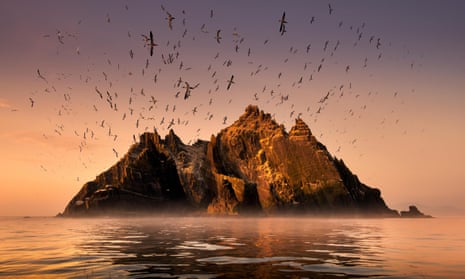St Brigid’s Island, a rocky crag off the west coast of Ireland, is the fictional setting for Lisa Carey’s novel. A place of wild beauty and soft days, in 1960 the island is approaching its evacuation, with the last few inhabitants promised new council houses with all mod cons on the mainland. Here traditional tiny boats still bear the mail, and the hearth fires are always kept burning.
Rose and Emer are twins married to two brothers. Rose, the pretty one, has a brace of children with handsome Austin. Emer is married to Patch, a pathetic drunkard; she wears a leather eyepatch and a sour face, and is neurotically overprotective of her only child, six-year old Niall. The sisters also look after their mammy, long disabled after a stroke and still mourning a dead son.
Niall, whose eyes have a hectic orange ring at the centre, may or may not be part fairy. Fairies are respected on this island, if not openly believed in. These are the sinister, mystical beings of the Celtic twilight, dangerous and unpredictable. Because of an unknown woman who had appeared at her bedside when she was giving birth, Emer is afraid that Niall will be stolen when he reaches the age of seven.
The first supernatural occurrence takes place quite far into the narrative. We flash back to five-year-old Emer seeing, in a moment of crisis, the veil of reality drawn aside like a curtain. Later, while she is digging turf, a hand emerges from the earth, “the size of a newborn’s but with long delicate nails iridescent as oyster shells”. Emer treasures these encounters and courts abduction by the little people. When Rose ruins her chance of ever being invited under the ground again, she is bereft. Her encounters with fairies leave her with an inner darkness, a terrible, indefinable longing, and “the fat worm of a keloid scar” instead of an eye. Her touch repulses people, giving them a terrifying shiver from “that place underneath who they believe they are”.
There is magic realism of a fine order in this book, and it works. The sheep tracks over the wild hillsides, the crumbling cottages, the fierce elements, the austere grandeur: all are beautifully caught. Carey has a great ear for the Irish vernacular, the music of the speech; and the domestic scenes and exchanges are excellent.
Then into this finely tuned world comes “the Yank”. Brigid has moved to the island that bears her name; her mother, who left 40 years ago, told her about a magic holy well, and this is what she’s looking for. The islanders, however, don’t share their well with strangers. Determined, she strides about the island with a big red dog, shedding hints about a backstory like a dark fairytale itself. In Brigid, Emer finds an object for her longing. Brigid, older and sexually experienced, responds.
The book is emotionally torrid, and a seam of violence runs through it. Carey plays with concepts, linking fairies with lust, rape, sexual pain and pleasure. Brigid, however, from her first appearance on the quay, with her bold charm and wild pre-Raphaelite hair, is less well realised than the other characters. A long digression into her past distracts from the weird dynamics of the island, and is less convincing than the fairies and the magic. Charmed with the island mythology of the saint born between two worlds, both pagan and Christian, “suckled on the milk of fairies”, Brigid dreams of an ideal female community of paired soul mates. Feminist ideas, sound in themselves, become intrusive and make the plot feel manipulated. There is also a whiff of condescension in the way she evolves into a kind of hero to the island women, enlightening them about their roles and becoming their natural leader. I found her cruel and vainglorious, but the sisters’ lives were fascinating and I wish the balance had been different.

Comments (…)
Sign in or create your Guardian account to join the discussion